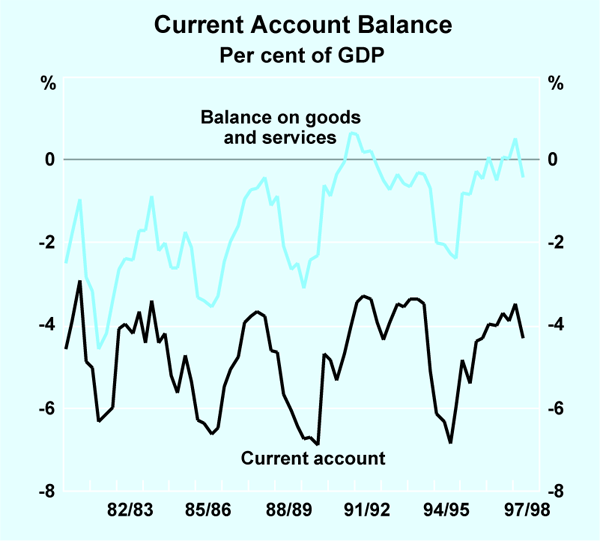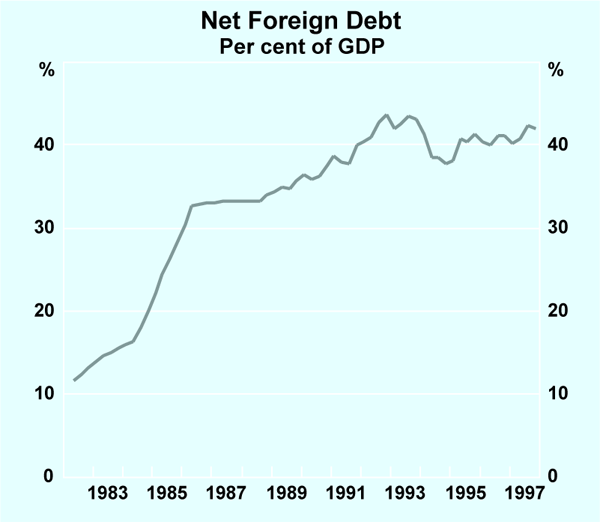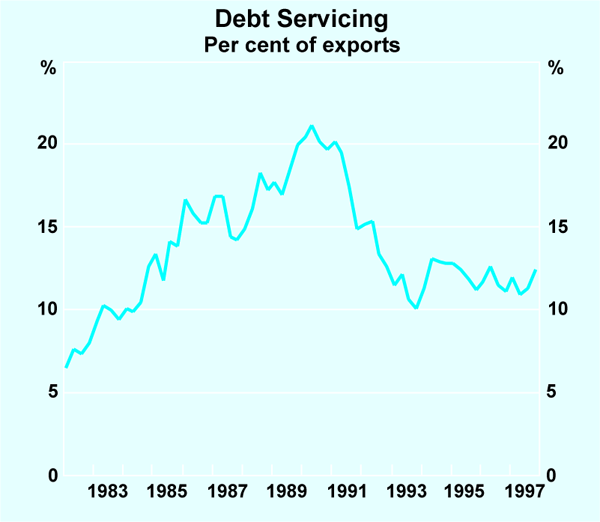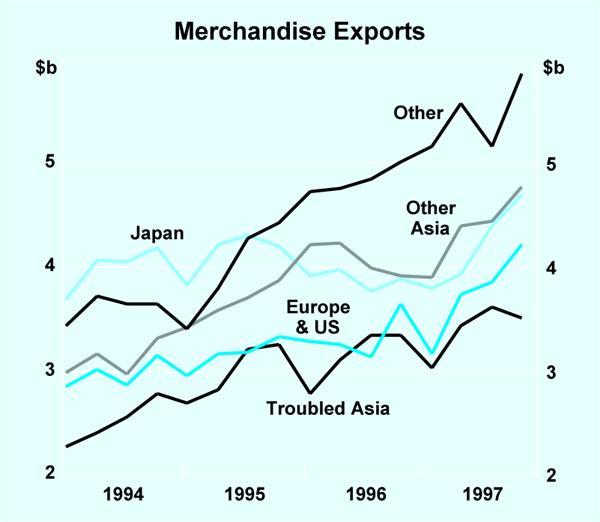Speech Some Thoughts on Australia's Position in Light of Recent Events in Asia

Ian Macfarlane
Governor
Talk to the Australian Stock Exchange, Australian Institute of Company Directors
and The Securities Institute of Australia, Bull and Bear Luncheon
Brisbane –
It is a pleasure to be here in Brisbane addressing the Australian Stock Exchange, the Australian Institute of Company Directors and The Securities Institute of Australia at their combined Bull and Bear Luncheon. I do not know whether I should nominate myself as a bull or a bear. Members of this audience will be able to make up their own minds after they have heard my story today.
Introduction
In the period since the collapse of Asian currencies – roughly since the floating of the Thai baht on 2 July 1997 – I have spent a fair amount of time, as have many others, trying to understand the reasons for that collapse. It has been a salutary experience, and it has caused many of us to re-examine some cherished views. I have already spoken twice on this subject, so I do not intend to cover the same material today. What I hope to do, however, is to draw some lessons from it, and to apply them to Australia.
In a previous speech,[1] I tried to identify the list of economic characteristics that would make a country vulnerable to a currency crisis or, worse, to a full-blown economic crisis. As you probably know, there is no definitive list that enables us to forecast these events with any precision, but there are about a dozen factors that seem to increase a country's vulnerability. If a country scores a very low mark on all of these factors, or at least most of these factors, there is a good chance that it would be subject to an international loss of confidence and ensuing economic problems. You will not be surprised to hear that Australia is not in this category; indeed, Australia scores a very high mark on most of these factors and thus should be in a very secure position. But we can never be complacent. Like all countries, we do not achieve a perfect score, and therefore it is worthwhile to go through a systematic examination of our strengths and weaknesses in light of the recent events.
Criteria for Vulnerability
The list of factors identified from our research[2] on the Asian crisis that pointed to the likelihood of a currency crisis or a wider economic crisis was as follows:
- Does the country have a fixed exchange rate and free movement of international capital?
- Is the exchange rate overvalued?
- Has a country with similar economic characteristics recently experienced a currency crisis?
- Is there a large budget deficit and a lot of government debt outstanding?
- Are there loose monetary policy and high inflation?
- Is the domestic economy in, or at risk of, a recession?
- Is there a large current account deficit?
- Is there a large amount of foreign debt?
- Is there an asset price boom (especially credit-driven) occurring?
- Are there a lot of bad debts in the banking system, and a poor system of bank supervision?
- Has there been a lot of unhedged foreign currency borrowing?
- Are there poor accounting standards, few disclosure requirements, ambiguous bankruptcy procedures, etc.?
A brief scan of this list should reassure people that Australia is in good shape. That is, it would receive a very favourable mark on the vast majority of these indicators, and so should be able to handle the current international turmoil without too much disruption. But we are not perfect, and there are two items on the list – the current account and external debt – where our score is low by international standards. In the remainder of my talk today I would like to set out in more detail how Australia stacks up against the above list, starting with the ten factors on which we receive a very high score, and following roughly the same order as in the list above. I will cover the factors where we receive a high score quite quickly in order to leave room for a closer examination of the two weak points.
Australia's Strengths
Australia allows the free movement of international capital, but we certainly do not have a fixed exchange rate. The Australian dollar was floated in December 1983, and after a few years of turbulence in the mid 1980s, has generally behaved as a floating rate should in the period since then. While it was more volatile in the 1980s than the major currencies such as the US dollar, yen and Deutsche Mark, in the nineties it has generally been less volatile than they have. It has varied cyclically over the past dozen years, but around a flat trend.
There is no evidence to suggest that it is overvalued. Opinions will always differ on such a subject, but at the moment there are probably more, including some influential offshore institutions, inclining to the opposite view. Like most currencies, it has depreciated against the US dollar over the past 18 months, but against the Trade-Weighted Index it has been relatively stable. Judged by other measures of the exchange rate designed to capture competition with imports or against export competitors, it has shown a small increase in competitiveness.[3]
The issue of contagion can be addressed by asking whether another country with similar economic characteristics has recently experienced a currency crisis. The answer is in the negative: all the countries that have recently experienced a currency crisis have been at an earlier stage of economic development than Australia, particularly in respect of the depth of their financial infrastructure and the degree of prudence exercised by borrowers and lenders. The financial markets have made a clear distinction between troubled Asian economies like Thailand, Indonesia and Korea and countries like Australia.
On fiscal policy, little needs to be said other than that Australia has a very low underlying budget deficit by world standards and is expecting a surplus next financial year. The stock of government debt to GDP (which effectively measures the extent of accumulated past deficits) is exceptionally low by international standards. On monetary policy, seven years of low inflation has finally received the international recognition it deserves. The international bond markets have expressed their confidence in Australia's fiscal and monetary policies by reducing the spread between Australian and US yields to the lowest margin in a generation.
In the aftermath of the currency crisis which resulted in the partial breakdown of the European Monetary System in 1992, the view developed that if a country was in or near recession, it would be particularly vulnerable to a currency crisis. This is because it would not be able to resist the currency crisis with tighter policies. (Whether it should, of course, would depend upon the circumstances.) Whatever the strength of this argument – and it is strongest for fixed exchange rate cases – it clearly does not apply to Australia, as we have a buoyant domestic economy. Furthermore, Australia is recognised internationally as having had one of the best growth records among OECD countries this decade. (Only Ireland and Norway – two very small economies – have done better.)
I will delay discussion of the current account, the balance of payments and foreign debt until after I have completed the list of positive factors for the Australian economy. The next factor on my list was whether the country was in the midst of an asset price boom. The problem with asset price booms is that they are usually followed by asset price busts, which can give rise to company insolvencies and banking problems. Clearly, this is not the case in Australia at present, although we do have fresh in our memories the events of the late eighties and so cannot be too censorious of recent Asian events. While the Australian share market has risen over recent years, it has done so by a smaller amount than the United States or most of Europe. Commercial property prices have also been relatively restrained, and while house prices are rising, the large rises have been confined mainly to inner Sydney and Melbourne.
I think we can be confident that our system of bank supervision is at world best practice, and the ratio of bad debts to total loans, at 0.9 per cent, is at its lowest level since statistics have been collected (admittedly, the collection only dates back to 1991). Of course, what currently seems to be a good loan can become a bad debt if circumstances change. Even so, I have a lot of confidence that our figures are a good guide to the health of our banking system.[4]
I think it is true to say that there has not been a lot of unhedged foreign currency borrowing occurring among Australian corporates since the days of the ‘Swiss franc loans’ of the mid-eighties, but I will postpone discussion of that topic until I deal with foreign debt in the second half of this talk.
Accounting standards, disclosure requirements and bankruptcy procedures are what might be termed financial infrastructure. So is the existence of a large group of equity analysts and financial journalists, the ASC and stock market listing requirements. We tend to take a lot of this for granted, but it is very important that they be up to best international practice. Again, we should not feel too superior to our Asian neighbours in this respect; it takes decades or more to develop these, and as recently as the late eighties we still had some glaring deficiencies. I think we are now at international best practice, but it still involves continued improvement to stay there.
Australia's Weaknesses
While I am satisfied that the underlying structure of our economy, particularly its financial underpinning, is sound, there is no sensible way we can avoid a widening of our current account deficit in the short term. It is virtually inevitable because a significant number of the countries that make up our major export markets are likely to contract, or not grow as quickly, over the next 18 months. It is what economists call an ‘external shock’. It is also true, of course, that if exports are weaker, then GDP growth will also be lower than it would have been without the ‘external shock’. These ‘real’ effects on exports and growth are already occurring, though their full effects will take some time to be clear. In the case of financial prices, such as the exchange rate, bond yields, commodity prices and share prices, of course, the adjustments occur at once, as market participants can immediately adjust prices to reflect their expectations of what is to come.
What I wish to do in the remainder of this talk is to try to address two questions. First, how will the Australian and international financial community accept the widening of the Australian current account? This is important because it has implications in the first instance for financial prices. Second, what are the prospects for our exports, and hence economic growth? I will not answer this question in a quantitative way, which may disappoint those who want numerical forecasts; in fact, I will be making a few criticisms of the simple models that are often employed for this purpose.
Reaction in financial markets
In the mid-eighties, Australian financial markets – particularly the foreign exchange and bond markets – experienced a major reaction to the widening current account deficit. The reason the reaction was so large was that doubts began to emerge about whether the economic situation was sustainable, particularly in view of the implications for foreign debt. There is always the possibility that the same or similar doubts will re-emerge over the next 18 months, but I am inclined to think that will not be the case. The reasons for my view are set out below.

If we look at the history of the current account since the early 1980s (Graph 1), it is apparent that the deficit has varied between about 3½ per cent and 6½ per cent of GDP, with an average of 4¾ per cent. Most importantly, there has been no on-going trend deterioration – the trade account has improved at a rate sufficient to offset the increase in net income payable abroad. The widening in the current account deficit that we expect in 1998/99 will be the fifth such cyclical widening in the past 20 years, and I think that people now accept this as a part of our economic cycle.
You will note that I am only talking about cyclical movements in the current account. The broader issue of whether we should accept an average current account deficit of 4¾ per cent of GDP in the long run would require another paper as long as the one I am presenting today. It would focus on our national savings performance, both in respect to governments and to the incentives that are provided to the private sector. But that is for another day.
On previous occasions, the cyclical widening of the current account deficit usually reflected a mixture of external influences, such as a fall in the terms of trade, plus some significant internal imbalances or policy deficiencies. As examples of the latter, domestic demand in the earlier widenings ran at unsustainably fast rates, usually in excess of 7 per cent per annum for a time. Similarly, in all but one of the earlier widenings, Australia's inflation rate was higher than the world average, and again on two occasions, we were running a significant budget deficit. On this occasion, we have none of these imbalances. The widening of the current account deficit will be essentially the result of an external contraction of demand, with domestic demand running only slightly faster than trend.
The foreign debt situation is not as threatening now as the most pessimistic people in the mid-eighties feared. Looking at a graph of the ratio of foreign debt to GDP (Graph 2) shows that it nearly tripled between 1982 and 1986 (from 12 per cent to 33 per cent). Many people feared that it would continue to rise at this rate, but it has not. In the nineties, it has averaged a little over 40 per cent, where it currently is. Another widely used measure of debt sustainability – the ratio of debt servicing to exports (Graph 3) – showed a somewhat similar pattern. It rose from 6 per cent to 22 per cent in the 1980s, but then reversed sharply in the early nineties, and is currently at about 12 per cent. The strong growth of Australian exports and the fall in world interest rates are largely responsible for this favourable development.


In the 1980s, when the sharp rises in foreign debt and its servicing costs were occurring, the Australian economic debate was, not surprisingly, pre-occupied with these issues. At the time, there were no official statistics comparing foreign debt levels in developed countries, and in their absence there was a tendency for people to assume the worst – that is, to assume that Australia was the highest on the list. Now that the IMF and OECD publish official statistics on the subject (Table 1), we see that we should not have assumed the worst. While Australia is certainly in the top quartile of countries ranked by the net foreign debt to GDP ratio, it is not the highest – New Zealand, Sweden and Canada are higher. Looking at the gross external debt to GDP ratio, Australia is in the bottom half of the table.[5]
| Net Debt | Gross Debt | |||
|---|---|---|---|---|
| New Zealand [1996] | 64.2 | Ireland [1996] | 143.1 | |
| Sweden [1996] | 45.2 | Sweden [1996] | 101.7 | |
| Canada [1996] | 44.8 | Switzerland [1995] | 96.0 | |
| Australia [1996] | 40.2 | Denmark [1995] | 89.0 | |
| Greece [1993] | 33.3 | Netherlands [1994] | 88.3 | |
| Finland [1996] | 31.6 | Canada [1996] | 77.7 | |
| Denmark [1995] | 29.9 | New Zealand [1996] | 75.6 | |
| Ireland [1996] | 29.8 | Finland [1996] | 74.0 | |
| United States [1996] | 20.2 | Austria [1996] | 73.4 | |
| Austria [1996] | 12.3 | Greece [1993] | 62.4 | |
| Italy [1996] | 6.0 | France [1995] | 57.2 | |
| Spain [1995] | 3.8 | Germany [1995] | 57.2 | |
| Norway [1993] | 3.7 | Australia [1996] | 55.9 | |
| Germany [1995] | −2.1 | Italy [1996] | 54.0 | |
| France [1995] | −2.8 | Norway [1993] | 49.0 | |
| Portugal [1993] | −6.7 | Portugal [1993] | 48.6 | |
| Netherlands [1994] | −19.7 | Spain [1995] | 44.3 | |
| Japan [1996] | −19.9 | United States [1996] | 42.6 | |
| Switzerland [1995] | −99.0 | Japan [1996] | 33.0 | |
| United Kingdom | n.a. | United Kingdom | n.a. | |
|
Source: IMF, Balance of Payments Statistics Yearbook 1997 |
||||
The other aspect of foreign debt that has received a lot of attention in the light of recent Asian developments is the extent of unhedged foreign currency borrowing. Official figures only tell us that 60 per cent of Australian borrowing is denominated in foreign currency. Of that, a significant proportion has been borrowed by banks, and this is virtually all hedged. Our assessment is that major Australian corporates normally hedge their foreign currency borrowing unless they choose not to because they have a natural hedge through their exports.
As I mentioned, financial markets tend to be forward looking, and it is likely that a significant deterioration in the current account is already factored into important financial prices. The reaction of financial markets to date has been more measured than was the case in the 1980s, no doubt reflecting their assessment of the much improved ‘fundamentals’ of the Australian economy. But we should not take this for granted. We have seen in Asia over the past year just how fast the international capital markets can react if they come to the judgment that a country is not being managed in a sustainable way.
Slowdown in exports
We would all like to know how large the current slowdown in exports will prove to be. But, because we have not been through this type of situation before, there is a lot of uncertainty about how to go about this.
To date, those trying to be scientific and quantitative have tended to use a model which I would term a ‘fixed co-efficient input-output model’. This approach starts by forecasting the fall in import volumes which each of our trading partners will experience and assumes that the volume of our exports to each country will fall by a similar amount. After adding together the results for each country, it arrives at a figure for Australian exports to the region. This is a time-honoured approach, but I am sceptical of how appropriate it is for a country in Australia's position.
Despite Australia's impressive export diversification of the past decade, about 60 per cent of our exports are still essentially rural and resource commodities which are sold onto world markets. Most of these are fungible – they are sold to wherever the demand is. If Korean demand for base metals falls, Australia will still probably sell the same amount of base metals worldwide as before, but with more sales to countries other than Korea. Of course, if world demand has weakened, the price will have to fall to clear the market. That is what has been happening – commodity prices are now 9 per cent lower than at their March 1997 high in SDR terms. Thus, from Australia's perspective, the Asian slowdown may have its biggest effect not through lower export volumes, but through a fall in commodity prices, some (or, conceivably, a lot) of which has already happened because these markets are forward looking. There is still an effect on the economy, of course, since lower prices, other things being equal, mean lower export income, which in turn means lower demand and so on. It is important to note, however, that other things have not been equal: the Australian dollar has depreciated such that in $A terms, commodity prices are actually higher than a year ago.
A good example of exporters seeking other markets is shown when we consider the recent history of our exports to Japan, by far our largest export market during the 1990s. As you know, the Japanese economy has been extremely weak over the past five years, and our exports to Japan have been flat over most of that period.[6] But this has not stopped overall Australian export volumes growing strongly; they have risen at an average annual rate of 7½ per cent in real terms over the past five years. Where has the growth come from? Just about everywhere but Japan, including, until recently, the other Asian countries that are currently in trouble. The most striking feature, however, has been the growth in a group of countries we have always called ‘other’. As you can see from Graph 4, this is our fastest growing market in recent years. To satisfy your curiosity, ‘other’ is what we have left after we exclude Asia, the United States and Europe: that means it includes the Middle East, New Zealand, the Indian Sub-Continent, the Former Soviet Union, Eastern Europe, South America, etc.

Another reason why the conventional approach to estimating the effects of Asia on Australian exports may overstate the slowdown is that a significant proportion of our exports are inputs into Asian exports, rather than final consumer or investment goods. This seems to be the case particularly for the two largest Asian markets – Japan and Korea. The situation is not as clear for some other countries, but as a general rule, we are probably better off in current circumstances than most suppliers because of the weight of commodities, foodstuffs and ‘inputs into exports’ in our mix. After the transitional export finance problems are solved, we should expect to see strong growth in Asian exports as a result of their large increase in competitiveness. I would be a lot more worried if Australian exports consisted of consumer products. Incidentally, this is one of the reasons why tourism has been hit so hard – it is probably our biggest export that is aimed directly at households, and is considered by them something of a luxury.
I hope I have not gilded the lily too much in the above discussion. There is no doubt we will find the going tough on the export side, and we will not be able to repeat in the short term the sort of figures we have become used to over the past five years. But I think not enough account in popular discussions has been taken of our particular mix of exports and our capacity to find new markets.
Conclusion
The events in Asia have confronted us with a challenge that was not foreseen a year ago. In deciding how to handle it, the first step is to recognise that the outlook for the economy is less favourable than it would have been in the absence of these events. The optimal policy response will be to accept that the effects should be spread across several economic variables, rather than attempting to adhere closely to earlier aspirations for any one variable, and letting the others do all the adjustment. It is clear that we should be prepared for a higher current account deficit in the short run – to try to avoid it would place intolerable strains on the rest of the economy. Similarly, we will have to accept a somewhat lower rate of economic growth and slightly higher inflation than seemed likely not so long ago. Notwithstanding these changes, we feel that over the next 12 months, Australia will continue to experience an economic outcome which will place it among the better performers in the OECD area. We also believe that our economic fundamentals will hold us in good stead, and that we will retain our hard-won reputation as a country with responsible economic and financial management.
Endnotes
‘The Asian Situation: An Australian Perspective’, Reserve Bank of Australia Bulletin, March 1998. [1]
We drew heavily on other work in this area, for example, Morris Goldstein, ‘Comments on Early Warning Indicators of Financial Instability in Emerging Economies’, Federal Reserve Bank of Kansas City (forthcoming) and Graciela Kaminsky, Saul Lizondo and Carmen Reinhart, ‘Leading Indicators of Currency Crises’, IMF Working Paper, July 1997. [2]
See ‘Alternative Measures of the Effects of Exchange Rate Movements on Competitiveness’, Reserve Bank of Australia Bulletin, January 1998. [3]
In many developing countries, official statistics on bad loans are thought to greatly underestimate the true figure. Even so, Mexico and Thailand reported ratios of 10.5 per cent and 7.7 per cent in the year before their economic crises. [4]
Depending on the purpose at hand, there can be a case for looking at either net debt or gross debt. If the purpose is to ask how vulnerable a country is to a currency crisis, gross debt (as has been used in the recent Asian episodes) is the better measure. It shows the amount of foreign lending that potentially would not be renewed if serious doubts developed over a country's future. The fact that the domestic private sector also had some foreign loan assets (as taken into account in net debt measures) would be of little assistance in such a currency crisis. [5]
Until the last nine months, when they rose apparently in line with a pick-up in Japanese exports. [6]